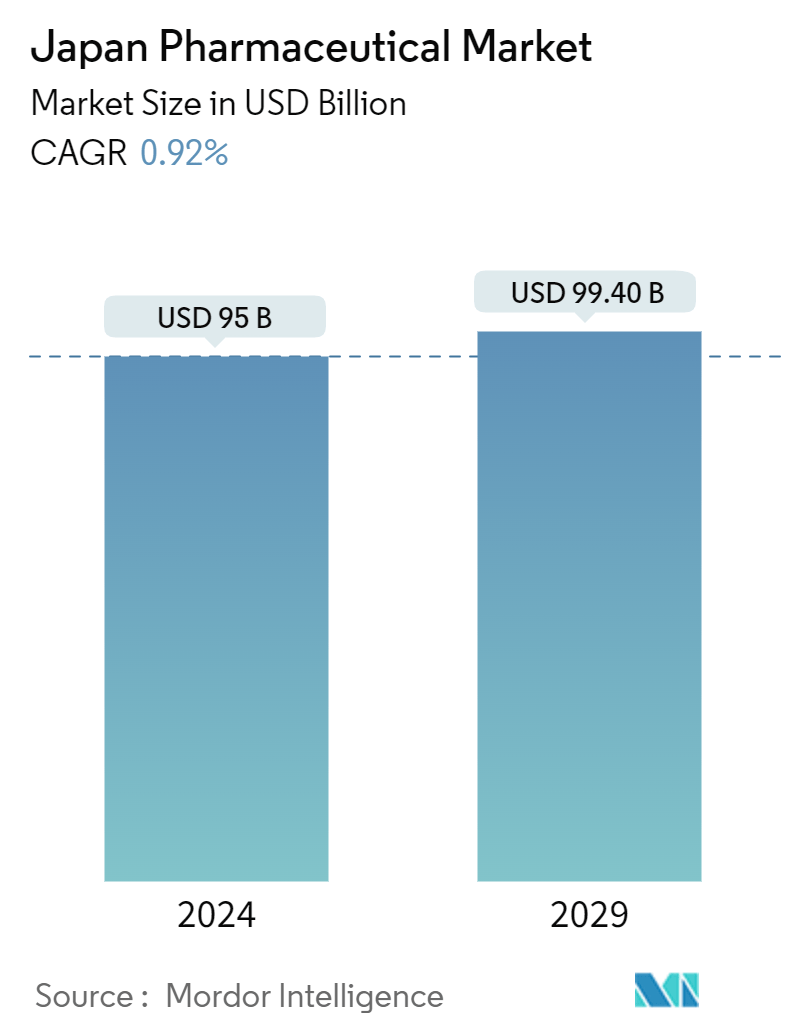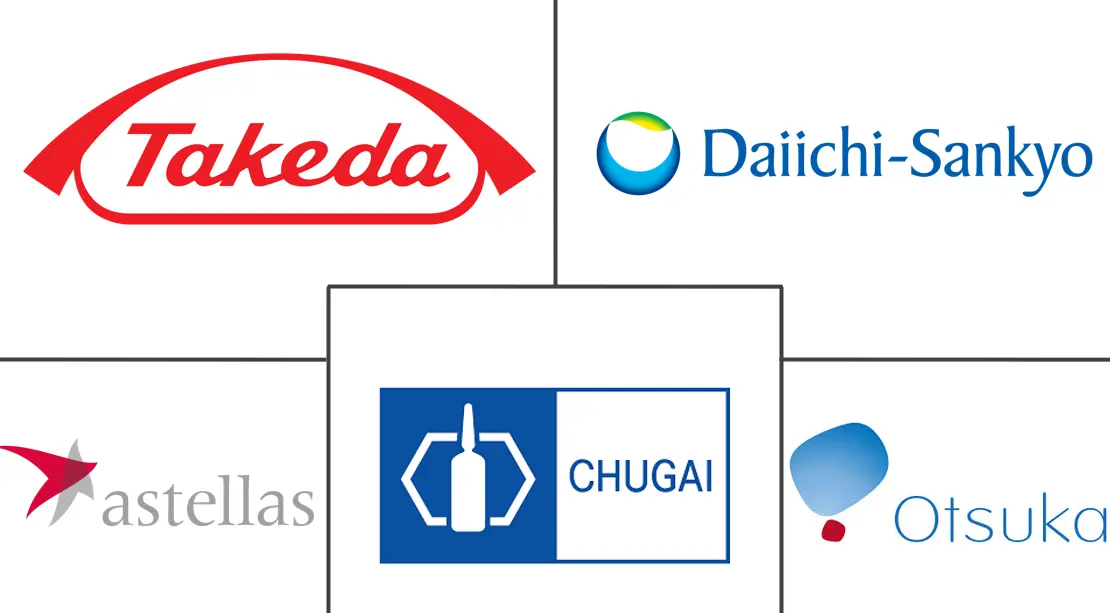Market Size of Japan Pharmaceutical Industry

| Study Period | 2019 - 2029 |
| Base Year For Estimation | 2023 |
| Market Size (2024) | USD 95 Billion |
| Market Size (2029) | USD 99.40 Billion |
| CAGR (2024 - 2029) | 0.92 % |
| Market Concentration | Low |
Major Players
*Disclaimer: Major Players sorted in no particular order |
Japan Pharmaceutical Market Analysis
The Japan Pharmaceutical Market size is estimated at USD 95 billion in 2024, and is expected to reach USD 99.40 billion by 2029, growing at a CAGR of 0.92% during the forecast period (2024-2029).
Factors such as the rising geriatric population, the growing prevalence of chronic diseases, and increasing R&D activities in the country are boosting the market's growth.
The significantly high percentage of chronic diseases such as cardiovascular diseases, diabetes, hypertension, cancer, and neurological diseases drive the market's growth. For instance, according to the article published by the National Library of Medicine in February 2023, the prevalence rates for various neurological conditions in Japan in 2022 were as follows: Parkinson's disease (PD) at 23.3%, epilepsy at 20.7%, stroke at 15.8%, dementia at 13.2%, immune-mediated neurological disease (IMMD) at 8.3%, spinocerebellar degeneration (SCD) at 8.1%, amyotrophic lateral sclerosis (ALS) at 3.9%, headache at 3.9%, and myopathy at 2.8%. Thus, the high percentage of people suffering from various disorders is anticipated to increase the demand for effective drugs, boosting the market's growth.
As reported in an April 2023 article by the Japan Medical Association Journal, the overall prevalence of allergic diseases in Japan stood at 62.2% across all age groups. The specific prevalence rates for 2022 were: bronchial asthma (BA) at 14.7%, atopic dermatitis (AD) at 15.6%, food allergies (FAs) at 15.2%, allergic rhinitis (AR) at 47.4%, allergic conjunctivitis (AC) at 19.5%, metal allergies (MAs) at 1.9%, and drug allergies (DAs) at 4.6%. Thus, the high prevalence of allergies is anticipated to increase the demand for drugs to treat them, which may further fuel the market's growth during the forecast period.
Japan’s growing population and the rising prevalence of chronic diseases significantly impact the country’s pharmaceutical market. For instance, according to the World Economic Forum updated in September 2023, Japan boasts a demographic in which over 10% of its populace was 80 years or above in 2023, solidifying its position as the nation with one of the most aged populations globally. In addition, as per the same source, nearly 1 in 3 Japanese citizens, equating to approximately 36.23 million people, were over 65 in the same year. This figure is expected to rise over the coming years, driving the need for more pharmaceuticals as aged individuals are more prone to various diseases such as cancers and cardiovascular diseases.
However, government policies and drug pricing pressure are expected to hinder the market's growth during the forecast period.
Japan Pharmaceutical Industry Segmentation
As per the scope of this report, pharmaceuticals are referred to as prescription and non-prescription drugs. These medicines can be bought by an individual with or without a doctor's prescription and are safe for consumption to treat various diseases.
The Japanese pharmaceutical market is segmented by therapeutic category and prescription type. By therapeutic category, the market is segmented into antiallergics, blood and blood-forming organs, cardiovascular system, dermatological, genito urinary system, respiratory system, sensory organs, and other therapeutic categories. By prescription type, the market is segmented into prescription drugs and OTC. Prescription drugs include branded drugs and generic drugs. The market size and forecasts are provided in terms of value (USD) for the above segments.
| By Therapeutic Category | |
| Antiallergics | |
| Blood and Blood-forming Organs | |
| Cardiovascular System | |
| Dermatologicals | |
| Genito Urinary System | |
| Respiratory System | |
| Sensory Organs | |
| Other Therapeutic Categories |
| By Prescription Type | ||||
| ||||
| OTC Drugs |
Japan Pharmaceutical Market Size Summary
The Japanese pharmaceutical market is poised for steady growth, driven by a combination of demographic shifts, increased disease prevalence, and robust research and development activities. The market is experiencing a surge in demand for prescription drugs, fueled by the rising geriatric population and the increasing incidence of chronic diseases such as cancer, cardiovascular conditions, and neurological disorders. The COVID-19 pandemic has further accelerated market expansion, with heightened demand for vaccines and therapeutics. Regulatory bodies like the PMDA and MHLW play a crucial role in ensuring the safety and efficacy of pharmaceutical products, facilitating a conducive environment for market growth. The market's competitive landscape is characterized by the presence of major players like Takeda Pharmaceutical Company Limited, Pfizer Inc., and Chugai Pharmaceutical Co. Ltd, who are actively engaging in strategic collaborations and product launches to strengthen their market positions.
The market's growth trajectory is supported by significant investments in research and development, aimed at developing innovative therapeutics and addressing the evolving healthcare needs of the population. The increasing focus on chronic disease management and the development of advanced drug formulations are expected to drive the market forward. Additionally, the respiratory segment is anticipated to witness substantial growth due to the rising prevalence of respiratory diseases among the aging population. Despite the promising growth prospects, the market faces challenges from stringent regulatory requirements that could potentially hinder the introduction of new products. Nonetheless, the overall outlook for the Japanese pharmaceutical market remains positive, with a strong emphasis on innovation, strategic partnerships, and addressing the healthcare demands of a rapidly aging population.
Japan Pharmaceutical Market Size - Table of Contents
-
1. MARKET DYNAMICS
-
1.1 Market Overview
-
1.1.1 Healthcare Expenditure
-
1.1.2 Pharmaceutical Imports and Exports
-
1.1.3 Epidemiology Data for Key Diseases
-
1.1.4 Regulatory Landscape/Regulatory Bodies
-
1.1.5 Licensing and Market Authorization
-
1.1.6 Pipeline Analysis
-
1.1.6.1 By Phase
-
1.1.6.2 By Sponsor
-
1.1.6.3 By Disease
-
-
1.1.7 Statistical Overview
-
1.1.7.1 Number of Hospitals
-
1.1.7.2 Employment in the Pharmaceutical Sector
-
1.1.7.3 R&D Expenditure
-
-
1.1.8 Ease of Doing Business
-
-
1.2 Market Drivers
-
1.2.1 Increasing Burden of Chronic Diseases and the Aging Population
-
1.2.2 Increasing R&D Activities in the Country
-
-
1.3 Market Restraints
-
1.3.1 Government Policies and Drug Pricing Pressure
-
-
1.4 Industry Attractiveness - Porter's Five Forces Analysis
-
1.4.1 Threat of New Entrants
-
1.4.2 Bargaining Power of Buyers/Consumers
-
1.4.3 Bargaining Power of Suppliers
-
1.4.4 Threat of Substitute Products
-
1.4.5 Intensity of Competitive Rivalry
-
-
-
2. MARKET SEGMENTATION (Market Size by Value – USD)
-
2.1 By Therapeutic Category
-
2.1.1 Antiallergics
-
2.1.2 Blood and Blood-forming Organs
-
2.1.3 Cardiovascular System
-
2.1.4 Dermatologicals
-
2.1.5 Genito Urinary System
-
2.1.6 Respiratory System
-
2.1.7 Sensory Organs
-
2.1.8 Other Therapeutic Categories
-
-
2.2 By Prescription Type
-
2.2.1 Prescription Drugs
-
2.2.1.1 Branded
-
2.2.1.2 Generics
-
-
2.2.2 OTC Drugs
-
-
Japan Pharmaceutical Market Size FAQs
How big is the Japan Pharmaceutical Market?
The Japan Pharmaceutical Market size is expected to reach USD 95 billion in 2024 and grow at a CAGR of 0.92% to reach USD 99.40 billion by 2029.
What is the current Japan Pharmaceutical Market size?
In 2024, the Japan Pharmaceutical Market size is expected to reach USD 95 billion.

